
Black Gold Jewelry: A Complete Guide
 Black gold is a type of gold artificially blackened through various techniques. Like white gold or rose gold, black gold is another option for gold jewelry colors outside the traditional yellow.
Black gold is a type of gold artificially blackened through various techniques. Like white gold or rose gold, black gold is another option for gold jewelry colors outside the traditional yellow.
If you love all black everything, black gold jewelry may be the perfect choice for you. This gold shade brings an edgy, unconventional style that’s also sophisticated.
Is black gold a real gold? Sort of. Natural gold only occurs in yellow. Just like white gold or rose gold, black gold does not occur naturally; it must be altered to gain this color. But the gold base that is blackened is real gold.
Today, we’ll teach you all about black gold jewelry, how it compares to other black metals, how much it costs, and how to take care of it.
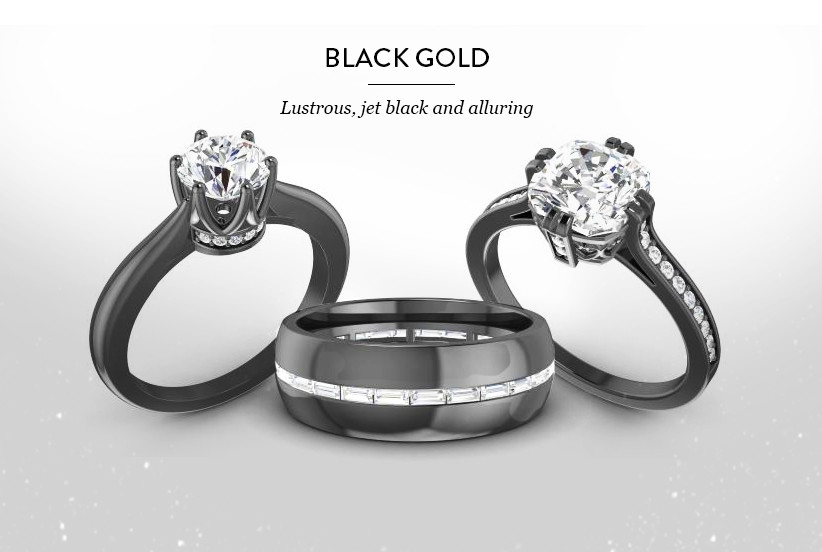
What Is Black Gold?
Although “black gold” is a common term used for oil or petroleum, it also refers to a colored gold.
Gold doesn’t occur naturally with black coloring. In fact, every gold outside of yellow gold must be altered to take on a new color.
For instance, rose gold is created by mixing yellow gold (the natural form) with copper, often in a 75 percent gold to 25 percent copper mixture to create 18K rose gold. On the other hand, white gold can be created by mixing yellow gold with metals like nickel, zinc, palladium, or a combination of these.
When you mix gold with other metals, it becomes an alloy. The additional metals you choose to mix in and the technique used to combine the metals determine the gold’s new color.
What is black gold made of? It depends on the technique, which we’ll cover next.

How Is Black Gold Made?
In terms of alloys, jewelers may add cobalt, rhodium, ruthenium, or a combination of these to gold to create to black gold.
There are a few different methods for creating black gold. The most popular method is electroplating, which we’ll cover first.
Electroplating
Electroplating is also called “electrochemical deposition,” “electrodeposition,” or simply “plating.” Although these terms may sound complex, this method is pretty straightforward.
The process involves prepping the metal (in this case, gold), then putting it into a solution. This solution contains a new metal that will become a coating on the gold. While the gold is in the solution, the jeweler runs an electric current through it, which allows the new metal’s molecules to bond to the original metal.
To create black gold, the solution must contain either black rhodium, nickel, or ruthenium. Black rhodium itself is formed by mixing in various alloys like ruthenium, tin sulfade, arsenic trioxide, or tellurium oxide to the rhodium.
The result is a dark gray, black, or gunpowder-colored metal — the exact shade depends on the alloys added to the rhodium.
The main drawback with electroplating is that it will eventually fade. You can always fix this by getting it replated.
Painting
A less common way to blacken gold is by painting a black liquid onto the gold’s surface. You can use acrylic paint or other paint-like liquids (like a mixture of Duco black paint and Duco thinner) to blacken gold this way. Once it’s dry, you’ll want to seal in the color with a thin varnish, polish, or anti-tarnish spray.
This type of black gold can chip more easily and it can be difficult to achieve an even color on more ornate jewelry designs, so it’s not the preferred technique for black gold jewelry.
Enamel
Another technique for creating black gold is by enameling. Enameling involves using very high heat (usually somewhere from 1,300 to 1,600°F) to fuse powdered glass to a metal.
You can create black gold by baking enamel onto yellow gold. The finished result is a smooth, lustrous, and hard black gold piece.
Pure gold is arguably the best metal for enameling, as it doesn’t tarnish. Enameling is among the most long-lasting methods for creating black gold — it’s often less likely to tarnish as quickly as an electroplated piece — but it’s also one of the priciest.
Oxidation
You can also create black gold via oxidation. This technique involves applying an acid to the gold’s surface, causing it to oxidize and darken.
Because pure gold doesn’t react with oxygen, oxidation requires a gold with karatage under 24 karat — meaning 22K, 18K, 14K, 12K, or 10K gold.
Oxidation can make the metals weaker, however, so it’s not ideal.
Laser Application
The last method is a relatively new one: femtosecond laser treatments. This technique involves using a laser to apply a pulse of high-volume energy onto the gold, forming microstructures that absorb light. The resulting piece looks black because it absorbs light instead of reflecting it.
Laser applications create the most durable black gold jewelry. However, they’re currently quite expensive, so they’re not as common. It may become more common and affordable if demand increases.
If you’re simply interested in black metal jewelry, you may want to know about some other black metal options.

Black Gold vs. Other Black Metals
Black gold is just one option for black metal jewelry. Some other black jewelry options are:
Black Ceramic
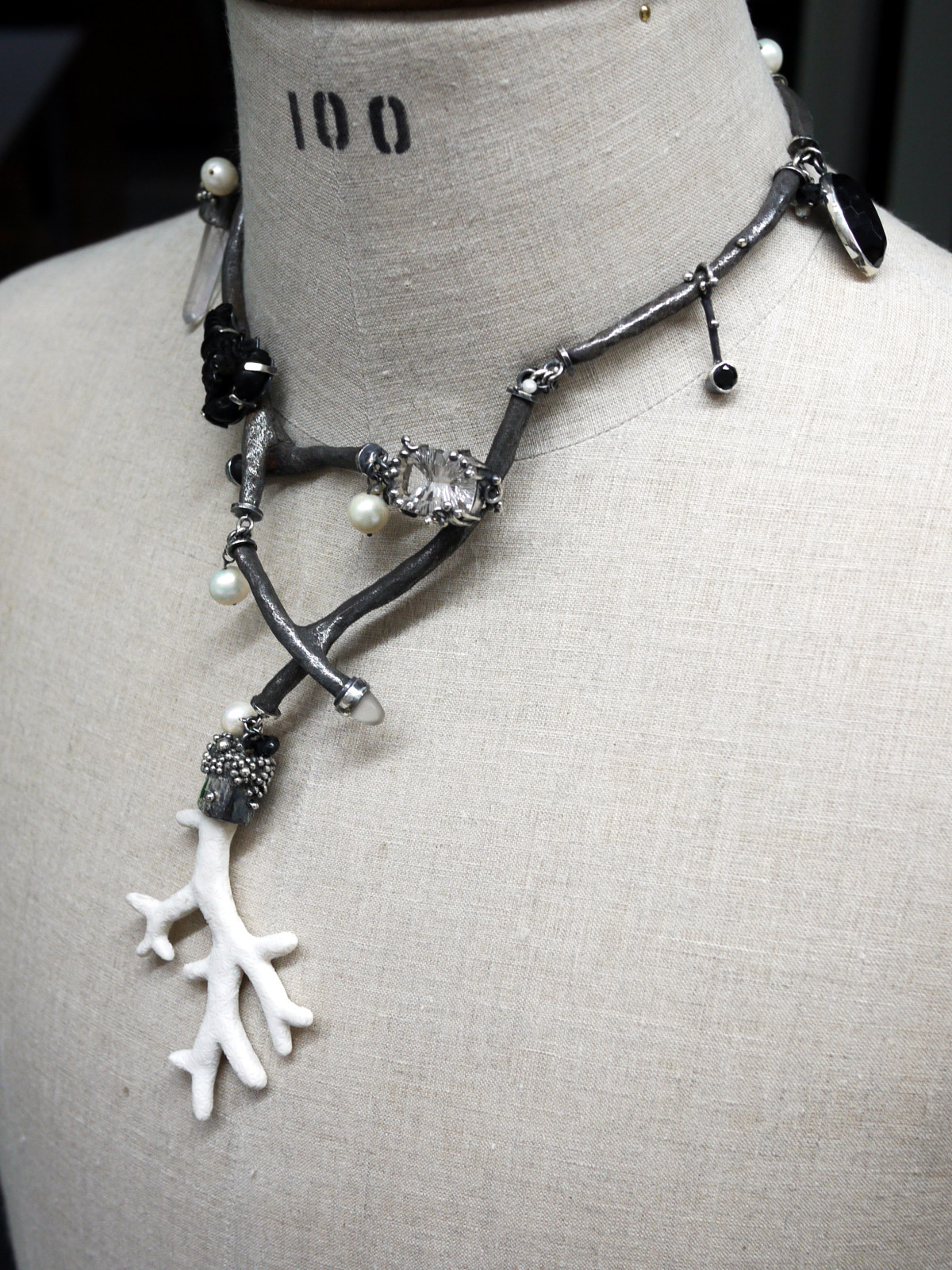 Image credit: the justified sinner | Flickr
Image credit: the justified sinner | Flickr
Black ceramic is a material used similarly to metals in jewelry. It’s very hard yet lightweight and doesn’t need a coating to be black. That means scratches won’t reveal another color hiding underneath.
One pro to black ceramic jewelry is that it’s lustrous and affordable. However, it’s more fragile and prone to breakage if dropped.
Black Tungsten

Another black metal option is tungsten. Like gold, tungsten must be treated to become black. The process involves shooting the tungsten with small, black titanium zirconium alloy particles at very high speeds so the particles adher to the metal.
Pros of black tungsten include being highly scratch-resistant, hypoallergenic, and highly tarnish-resistant. However, tungsten jewelry can shatter like ceramic jewelry and its durability makes it difficult to resize.
Black Titanium
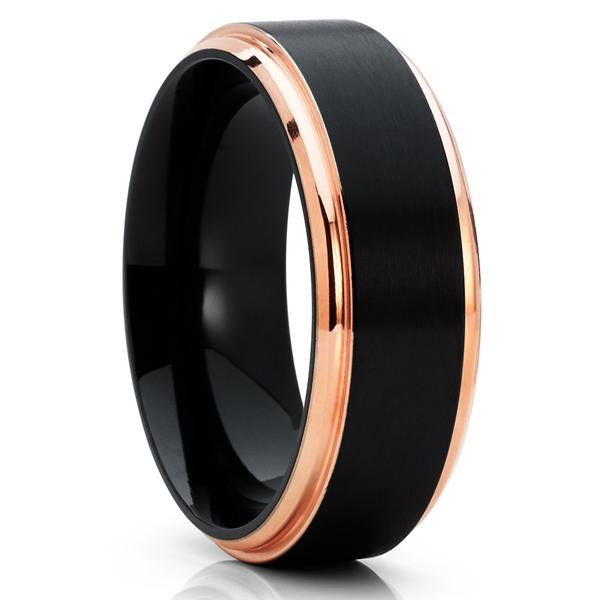
Titanium is the most popular choice for black metal jewelry.
Like gold, titanium doesn’t naturally occur in black. Black titanium is created by coating titanium with a diamond-like carbon (DLC). This forms a glossy, scratch-resistant, black surface layer. Using carbon allows the finished metal to be highly heat-resistant and very smooth to the touch.
Compared to other dark metals like black gold or silver, black titanium is often more durable and more budget-friendly. Black titanium is also hypoallergenic, corrosion-resistant, and chemically inert (meaning it won’t react to chemicals). The color shouldn’t fade or tarnish unless it’s put through extreme conditions.
The only drawback to titanium is that, like tungsten, the metal’s durability makes resizing difficult.
Carbon Fiber

Carbon fiber, or graphite fiber, is a polymer used similarly to other metals in jewelry. The material is super strong — 5 times stronger than steel, in fact! Yet, it’s also lightweight — 3 times lighter than titanium and 12 times lighter than gold.
Some pros of carbon fiber jewelry include being lightweight, durable, scratch-resistant, hypoallergenic, and conflict-free. Plus, this stylish type of black jewelry is affordable.
The only drawback to carbon fiber jewelry is that it’s not safe to wear if you work in electricity, as it’s conductive.
Black Stainless Steel
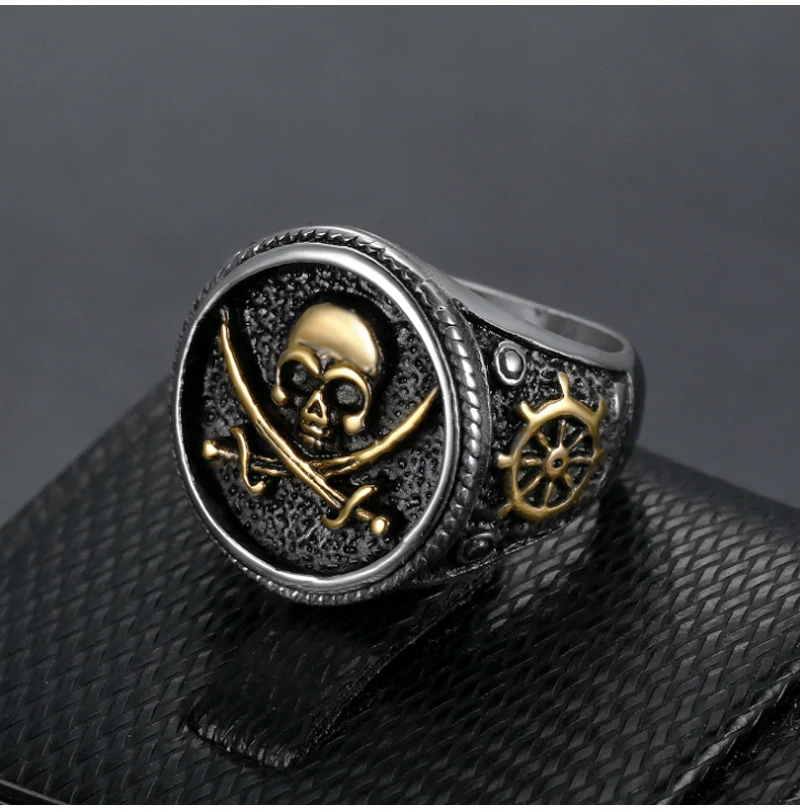
Stainless steel isn’t just for refrigerators — you can also find stainless steel black jewelry! There are two ways to create black stainless steal: acrylic-coating and anodizing.
Acrylic-coating involves coating stainless steel in black acrylic. But this coating will easily scratch off, so it’s not great for jewelry.
Most black stainless steel jewelry is anodized. Anodizing is similar to electroplating, but instead of coating a different metal onto the existing metal, it builds up the existing metal’s natural oxide layer, creating a thicker oxide surface layer.
In this case, the stainless steel’s oxide layer is black. From there, the jeweler heats the stainless steel until it displays the ideal black shade and luster.
Technically, stainless steel can’t be anodized, but blackened stainless steel created through the process above is still referred to as “anodized.”
Some pros of anodized stainless steel are that it’s resistant to corrosion and good for daily wear. However, you’ll want to add a protective coating to ensure its durability.
Zirconium
Zirconium is the only jewelry metal that can permanently turn black without complex processes. You don’t need any coatings; simply heating zirconium will turn it black because the heat forms a layer of zirconium oxide.
Some pros of zirconium are that it’s hypoallergenic, resistant to corrosion, very resistant to scratches, lightweight, and durable. Although tungsten is harder than zirconium, zirconium is less brittle than tungsten.
Damascus Steel
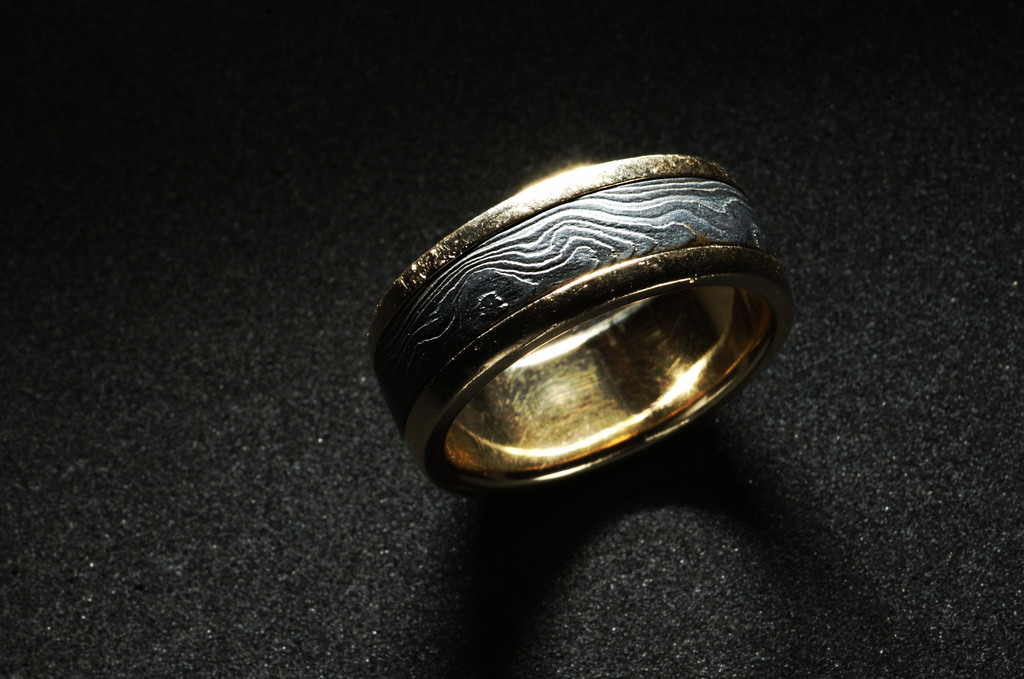
You’ve probably heard of Damascus steel weapons, but this metal can also be used in jewelry! Damascus steel is created by welding steel and iron layers between rounds of heat and forging. The result is a silver, gray, or black metal with a wavy pattern, often alternating between lighter and darker tones.
Beyond its unique appearance, Damascus steel is highly resistant to scratches, corrosion, and degrading. The metal is hard and flexible, making it great for ornate jewelry pieces.
The only drawback to Damascus steel is that it’s not a pure black metal, as it’s patterned and often leans toward silver.
Compared to all the black metals listed above, black gold is simply more valuable, though its value can depend on a few factors.

Black Gold Value
First, is black gold more expensive than gold? Technically, no, but it depends. The value of black gold depends on the purity (a.k.a. karatage) of the gold underneath.
Is there a 14K black gold? Yep, you can find black gold in any karatage except 24K, as 24K gold is 100 percent gold and colored golds are inherently impure. We recommend 14K gold or higher for the best value.
On the topic of karatage, black gold prices will mostly depend on the gold’s karatage. That means 18K black gold will be more valuable than 14K black gold. The process used to make the gold black may play a role as well — electroplated black gold will be more valuable than oxidized or painted black gold, while enamel or laser-applied black gold may be more valuable than electroplated black gold.
Have some gold jewelry you want to turn into black gold jewelry? Prices for rhodium-plating black gold jewelry are usually between $75 to $120.
When buying black gold jewelry, expect to pay extra for added gemstones or other embellishments.
Depending on the karatage, black gold jewelry could be an investment. So, how long does black gold plating last? And how do you keep it from tarnishing?
Caring for Black Gold
Black gold plating will usually last 6 months to 2 years, depending on how well the item was plated and how often you wear it.
Does black gold tarnish? Black gold is not pure gold, so it can eventually tarnish over time from contact with moisture, air, oils, and other substances. You can help prevent black gold from tarnishing by keeping it dry, storing it in an air-tight container, and using a jewelry protectant spray.
Does black gold fade? Electroplated black gold will eventually start wearing off, so fading is inevitable. When you see the yellow gold peaking through, it’s best to have it replated to restore the black color and shiny luster.
Besides avoiding scratches and bumps, you can also ensure your black gold jewelry lasts longer by cleaning it regularly.
How Do You Clean Black Gold?
In general, it’s best to gently clean any gold jewelry once a week. Here are the steps for safely cleaning black gold jewelry:
Fill a bowl with warm water and mix in a mild soap (like Dawn dish soap).
Dip a soft brush (like a toothbrush) or cloth into the soapy water, then gently wipe down the black gold jewelry.
Rinse off any soap residue.
Thoroughly dry the black gold jewelry piece with a soft, microfiber cloth.
Here are some more tips for ensuring your black gold jewelry lasts as long as possible:
Don’t wear another ring next to your black gold ring, as this could cause scratches.
Remove black gold jewelry before swimming, engaging in strenuous activities that could lead to sweating, or doing chores like washing dishes.
Apply any perfumes, lotions, or other beauty products (and allow to dry) before putting on your black gold jewelry.
Keep electroplated black gold jewelry away from chlorine and acids, as these could damage the plating.
Follow these steps and your black gold jewelry will be shining for years!
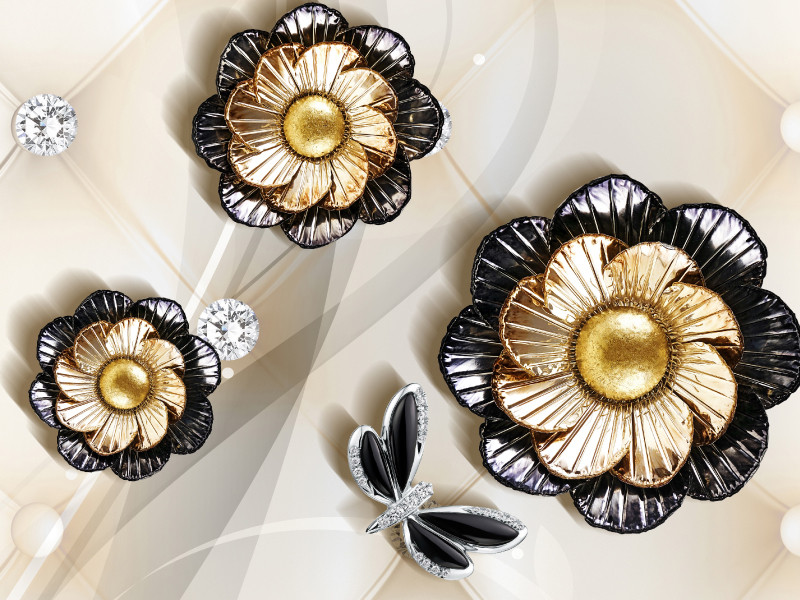
Want to Paint Your Jewelry Black?
If you see yellow gold and want to paint it black, black gold jewelry is the choice for you. The metal’s unique, edgy look offers an unconventional yet refined aesthetic that will pair perfectly with pretty much any look.
Ready to shop? Browse our collection of black gold jewelry!
Search the Fashion Encyclopedia
Related Auctions
Related Articles
How to buy a ruby for your ring or pendant,Make sure that you learn as much as you can about Rubies, prior to buying a ring or a setting that you are going to add Rubies to. Like Diamonds, Rubies can be flawed, and imperfect The Ruby is one of the most b
10th Apr 2019
A guide on buying loose Opals for Jewelry. Doublets and Triplets are perfect for making Jewelry with but there are factors you need to be aware of.
3rd Oct 2019
Latest Articles
Titanium is a popular jewelry metal known for being lightweight, durable, and affordable. Learn all about titanium, how it compares to similar metals, and the pros and cons of titanium jewelry.
7th Feb 2023
Learn all about tungsten jewelry - from its history and uses to its durability and care. By the end of our guide, you’ll know if tungsten is right for you!
7th Feb 2023
Thinking about adding some timeless white gold jewelry to your fine accessories collection? Here’s all there is to know about sophisticated white gold!
29th Jan 2023




